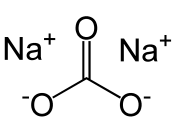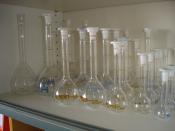Results Titre (cm3) Rough Titre 1st Accurate 2nd Accurate 3rd Accurate Start Titre 0.00 0.00 0.00 0.00 End Titre 27.15 26.55 26.50 26.45 Titre Result 27.15 26.55 26.50 26.45 Three concordant results, within 0.10cm3 were obtained, I will therefore calculate an average of these 3 results, using the following formula: 1st Accurate + 2nd Accurate + 3rd Accurate Number of Accurate results 26.55 + 26.50 + 26.45 = 79.5 = 26.50cm3 3 3 The percentage error of these titres can also be calculated: Maximum Result "ÃÂ Minimum Result x 100 = % error Average Result 26.55cm3 "ÃÂ 26.45cm3 x 100 = 0.40% (2.Sig Figs) 26.50cm3 1). Calculating the Concentration of the alkali solution.
This needs to be done so that the acid concentration can be worked out. The stronger the alkali the more acid that will be needed to neutralise it, so the strength of the alkali must be known.
A step-by-step method can be used to calculate the concentration of the alkali: Firstly, the number of moles of sodium anhydrous carbonate needs to be calculated using the following formula: Number of moles of compound = Mass of compound Relative Molecular mass of Compound Formula of sodium carbonate anhydrous = Na2CO3 Mass of compound used = 2.65g Relative Molecular Mass of Na2CO3 = (2x23) + (3x16) + 12 =106g mol-1 2.65g = 0.0250 moles of Na2CO3 106g mol-1 The molarity of the Na2CO3 solution must then be calculated: A 250cm3 volumetric flask was used and therefore there was 0.0250 moles of Na2CO3 in 250cm3 of water.
Because the units of molarity are measured in mol.dm-3, then the number of 250cm3 volumetric flasks that make up 1 dm3 must be calculated: 1000 = 4 amounts of 250cm3 in 1 dm3 250 The number of moles of sodium carbonate in 250cm3...



VERY NICE
Needs sources.
Concise.
Cant say much. proper discussion and stuff.well structured method.
0 out of 0 people found this comment useful.